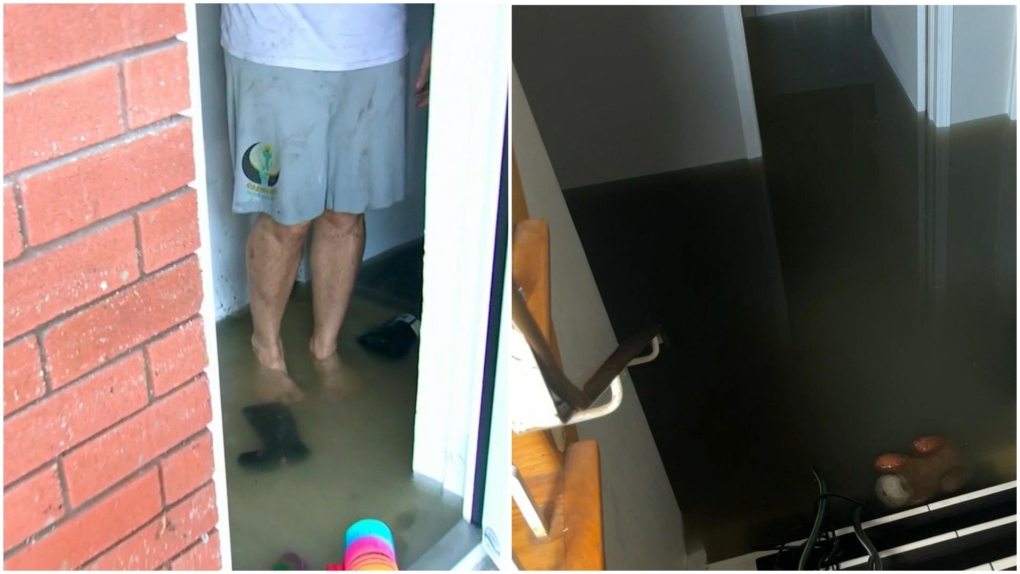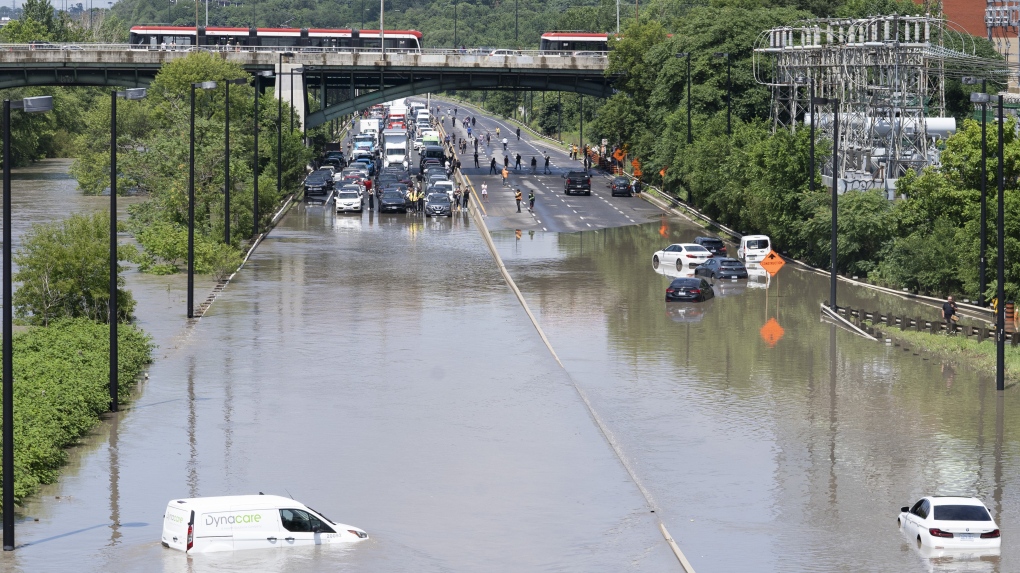Some Toronto homeowners facing flooded basements in wake of record-breaking storm
Toronto is still drying out after a storm dropped more than a month’s worth of rain on the city earlier this week, leaving some residents to deal with flooded basements and property damage left in its wake.
“I was literally shocked,” Karma Kunsang, a resident of the Rockcliffe–Smythe neighbourhood in Toronto’s northwest, told CTV News Toronto.
The area was particularly hit hard by Tuesday’s rainfall and the water levels in Kunsang’s basement reached knee-high height, destroying furniture and toppling over large appliances as the storm surged.
“This place, it was like a movie. When this happens to your own house, your brain stops working,” he said.
Eric Swanson lives nearby and saw at least a foot of water in his home’s lower level, despite installing a pressure-sealing door and powered backwater valve in the basement.
“Do we call insurance? Do we not call insurance? The mould and the disgustingness of the water and all those issues…I need to get this properly cleaned and taken care of so that my house is still livable,” Swanson said.
Homes weren’t the only things damaged in the record-breaking storm, which saw nearly 100 millimetres of rainfall in just a few hours. Several vehicles were also abandoned by their drivers after water gushed onto major roadways across the city, including the Don Valley Parkway where 14 people needed to be rescued.
The torrential downpour is already being compared to Toronto’s 2013 storm – listed as one of the most expensive natural disasters in Canada, according to insurance payouts. Data from the Insurance Bureau of Canada (IBC) shows that claims filed in the aftermath of that weather event reached $1 billion.
 The basements of Eric Swanson (left) and Karma Kunsang (right) were flooded following Tuesday's record-breaking storm in Toronto.
The basements of Eric Swanson (left) and Karma Kunsang (right) were flooded following Tuesday's record-breaking storm in Toronto.
While it’s too early to put a dollar figure on the damage left it the aftermath of Tuesday’s storm, the IBC told CTV News Toronto that the two events are “similar.”
“We can’t determine, at this point, what the magnitude of this event is,” Anne Marie Thomas, IBC’s director of consumer and industry relations, said. “We can’t say what this event will cost because, as you can imagine, not everyone has filed an insurance claim yet.”
Insurance tips for flooded house, car
If your basement was flooded or you needed to abandon your vehicle, the first thing you should do is reach out to you insurer or insurance broker to check your coverage.
“Not all [insurance] policies have coverage for weather events like this one,” Thomas said, adding that sewer backup coverage and overland flood coverage would be needed in the case of home insurance, both of which are optional and not always included in basic policies.
“A typical homeowner's insurance policy doesn't cover damage caused by sewer backup or flood. It only covers [damage] caused by a burst pipe or something like that in your home,” she said.
After you’ve determined what type of coverage you have, the next step is making an inventory of all the damaged items, including taking pictures and videos of those items. If you have proof of purchase, such as a receipt, for an item you’re looking to make a claim for, that will assist in the process.
One important note is to hold on to any damaged items before you dispose of them, because, as Thomas explains, the insurance adjuster will want to see the damage as it was at the time of the event.
“So if your house is damaged, and you go, ‘OK, I'm just gonna get rid of this.’ Wait until your insurance company says it's okay. Unless that item is posing a health hazard or is a danger,” she said.
As well, if you rented any equipment to dry out your home, such as a shop vac or industrial fan, keep those receipts as you could be reimbursed.
In terms of vehicle insurance for owners who were forced to ditch their vehicle amid the flooding, much like home insurance, only certain policies will cover the damage.
“In order for those vehicles to be covered by insurance, the owner of the vehicle would have to have purchased collision or comprehensive coverage or ‘all perils’ coverage,” Thomas said. “Those are the optional physical damage coverages that you can buy for your car. If you have that, then your insurance company would pay to either fix the vehicle or write off your vehicle.”
Typically, following a storm like the one on Tuesday, Thomas said the full “realization” of the damage isn’t known until 30 to 45 days after the event.
 Cars are partially submerged in flood waters in the Don Valley following heavy rain in Toronto, on Tuesday, July 16 2024. THE CANADIAN PRESS/Arlyn McAdorey
Cars are partially submerged in flood waters in the Don Valley following heavy rain in Toronto, on Tuesday, July 16 2024. THE CANADIAN PRESS/Arlyn McAdorey
CTVNews.ca Top Stories

'It's just not fair': Retirees speak out on being excluded from federal rebate cheques
Carol Sheaves of Moncton, N.B., says it's not fair that retirees like her won't get the government's newly proposed rebate cheques. Sheaves was among the seniors who expressed their frustrations to CTVNews.ca about not being eligible for the $250 government benefit.
Montreal mayor says Friday pro-Palestinian protests were taken over by 'professional vandals'
Montreal Mayor Valérie Plante told journalists 'professional vandals' took over protests and smashed windows at the Palais des Congres.
Warren Buffett gives away another US$1.1B, announces plans for distributing $147B fortune after death
Investor Warren Buffett renewed his Thanksgiving tradition of giving by announcing plans Monday to hand more than US$1.1 billion of Berkshire Hathaway stock to four of his family's foundations, and he offered new details about who will be handing out the rest of his fortune after his death.
Canada Post says progress 'limited' at negotiating table as strike continues
Canada Post says they have made 'limited progress' with the union at the negotiating table 11 days after the strike began.
BREAKING Judge delays resentencing hearing for Menendez brothers
A judge has delayed a scheduled resentencing hearing for Lyle and Erik Menendez.
Justin Trudeau defends spending record on military amid fresh criticism
Prime Minister Justin Trudeau is defending his government's record on supporting national defence, following fresh criticism that Canada is failing to live up to its NATO defence-spending commitments.
CEOs demand changes to Liberals' military spending plan
The federal government risks jeopardizing the economy unless it meets its NATO military alliance spending obligations within the next five years, says the Business Council of Canada.
U.S. driver makes wrong turn to Canadian border, gets arrested for unlawfully possessing a gun
A 62-year-old man from the U.S., who took a wrong turn to the Canadian border thanks to his GPS device, is now facing a firearms-related charge.
Toronto mother now facing murder charge in death of four-month old baby
Toronto police say they have charged a mother with second-degree murder following the death of her infant, who was found with critical injuries in midtown Toronto last week.
































